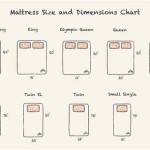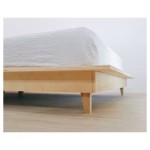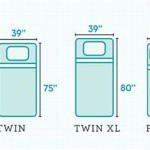What Are The Dimensions Of A Standard Full Size Bed?
The full size bed, also commonly referred to as a double bed, is a popular choice for individuals and couples who require more sleeping space than a twin bed offers, yet want a more compact option than a queen or king size bed. Understanding the exact dimensions of a full size bed is crucial for various reasons, including planning bedroom layout, selecting appropriate bedding, and ensuring compatibility with bed frames and accessories. Accurate knowledge of these dimensions facilitates informed decision-making during the purchasing process and optimizes the overall comfort and functionality of the sleeping environment.
The dimensions of a full size bed are generally standardized across manufacturers to ensure consistency and allow consumers to easily find compatible mattresses, bed frames, and bedding. However, minor variations can occur depending on the specific brand or style. This article provides a comprehensive overview of the standard dimensions of a full size bed, factors to consider when choosing a full size bed, and related information to assist in making an informed decision.
Standard Dimensions of a Full Size Bed
The standard dimensions of a full size bed are approximately 54 inches wide and 75 inches long. This translates to 4 feet 6 inches in width and 6 feet 3 inches in length. These dimensions are considered the industry standard and are generally consistent across different manufacturers. The surface area of a full size bed is therefore 4,050 square inches (54 inches x 75 inches). This area provides sufficient space for a single adult to sleep comfortably, with some extra room for movement. It can also comfortably accommodate two adults, although some couples might find it a bit cramped, particularly if they are accustomed to sleeping on a larger bed.
The width of 54 inches offers more room compared to a twin bed’s 38 inches, which provides roughly 16 inches of additional space. This extra width can be particularly beneficial for individuals who tend to move around during sleep. The length of 75 inches is the same as the length of a twin size bed, making it suitable for individuals who are under approximately six feet tall. Taller individuals might find the full size bed slightly short and may prefer a queen or king size bed for added legroom.
While the standard dimensions serve as a general guideline, it is important to note that slight variations may exist between different manufacturers. These variations are typically minimal, often within an inch or two, but it is always advisable to verify the exact dimensions with the retailer or manufacturer before making a purchase. Confirming the dimensions ensures compatibility with existing furniture, bedding, and other bedroom accessories.
The height of a full size bed is determined by the combination of the mattress thickness and the bed frame. Mattress thicknesses can vary widely, ranging from thinner profiles of around 6 inches to thicker profiles of 14 inches or more. Bed frames also come in various heights, affecting the overall height of the bed. Consider personal preference, ease of getting in and out of bed, and the overall aesthetic of the bedroom when determining the desired bed height.
Factors to Consider When Choosing a Full Size Bed
Several factors should be considered when deciding whether a full size bed is the right choice. These include the available space in the bedroom, the number of sleepers who will be using the bed, individual sleeping habits, and budget considerations. Evaluating these factors carefully will help determine if a full size bed meets specific needs and preferences.
Bedroom Size: The size of the bedroom is a primary consideration. A full size bed is a good option for smaller bedrooms where a queen or king size bed might overwhelm the space. Measure the room carefully to ensure that the bed will fit comfortably and allow for adequate walking space around the bed. Consider the placement of other furniture, such as dressers, nightstands, and wardrobes, when planning the bedroom layout. Ideally, there should be at least two feet of clearance around the bed to allow for easy movement.
Number of Sleepers: A full size bed can accommodate one or two sleepers. For a single adult, a full size bed provides ample space for comfortable sleep. However, for couples, a full size bed might feel somewhat cramped, especially if one or both individuals tend to move around a lot during sleep. If both sleepers prefer more personal space, a queen or king size bed would be a more suitable option. Consider the sleeping habits of both individuals when making this determination.
Sleeping Habits: Individual sleeping habits play a crucial role in determining the appropriate bed size. Individuals who tend to toss and turn or spread out while sleeping require more space. A full size bed may suffice for a single sleeper with these habits, but a larger bed might be necessary for a couple. If one person is a restless sleeper, a larger bed can help minimize disturbances to the other sleeper.
Budget: The cost of a bed is an important factor to consider. Full size beds are generally less expensive than queen or king size beds, both in terms of the mattress and the bed frame. Bedding and accessories for full size beds are also typically more affordable. Consider the overall budget when making a decision, factoring in the cost of the mattress, bed frame, bedding, and any other necessary accessories.
Future Needs: Consider potential future needs when choosing a bed size. If there is a possibility that the bed will be used by two people in the future, a larger bed might be a better investment. Similarly, if there is a likelihood of moving to a larger home with more bedroom space, a larger bed can be transitioned to the new space without the need for replacement.
Alternatives to a Full Size Bed
Depending on specific needs and preferences, several alternatives to a full size bed exist. These include twin beds, twin XL beds, queen beds, and king beds. Each of these options offers different dimensions and benefits, making them suitable for various circumstances.
Twin Bed: A twin bed is the smallest standard bed size, typically measuring 38 inches wide and 75 inches long. Twin beds are ideal for children, teenagers, or single adults who have limited bedroom space. They are also commonly used in guest rooms or bunk beds. While a twin bed is more compact than a full size bed, it may not provide enough space for adults who prefer more room to stretch out.
Twin XL Bed: A twin XL bed has the same width as a twin bed (38 inches) but is longer, measuring 80 inches in length. The added length makes it a suitable option for taller individuals who need more legroom but do not require the additional width of a full or queen size bed. Twin XL beds are frequently used in college dormitories and small apartments.
Queen Bed: A queen bed is larger than a full size bed, measuring approximately 60 inches wide and 80 inches long. The additional width and length make it a comfortable option for couples who prefer more sleeping space. Queen beds are a popular choice for master bedrooms and guest rooms. While a queen bed provides more room than a full size bed, it also requires more bedroom space and may not be suitable for smaller rooms.
King Bed: A king bed is the largest standard bed size, measuring approximately 76 inches wide and 80 inches long. King beds offer ample space for couples who want maximum sleeping space. They are also a good choice for individuals who tend to spread out while sleeping. Due to their large size, king beds require a spacious bedroom and may not be suitable for smaller rooms.
California King Bed: A California King bed is another option, measuring approximately 72 inches wide and 84 inches long. While narrower than a standard King, it offers additional length making it a good choice for taller individuals who require extra leg room. These also require a spacious bedroom because of their size.
In summary, the dimensions of a standard full size bed are crucial for planning bedroom layout, selecting bedding, and ensuring compatibility with bed frames. A full size bed, measuring 54 inches wide and 75 inches long, offers a comfortable sleeping space for a single adult and can accommodate two adults, albeit with less personal space than larger options. Considering factors such as bedroom size, number of sleepers, individual sleeping habits, and budget considerations will help to determine whether a full size bed is the right choice.

Mattress Sizes Chart And Bed Dimensions Guide Amerisleep

The Official Organic Mattress Size Guide 2025 Edition

Mattress Sizes Chart Bed Dimensions Guide Purple

A Guide To Choosing The Right Bed Size

Mattress Sizes And Dimensions Guide To See More Read It

Standard Bed Dimensions A Complete Guide Dimensionsly
Mattress Size Chart And Bed Dimensions Guide 2024

Standard Bed Size Chart Find 3 Ideal Sleep Solution

Ultimate Guide To Bed Size Dimensions Find The Perfect Fit

Bed Sheet Sizes And Dimensions Guide Standard Oversized Sheets








